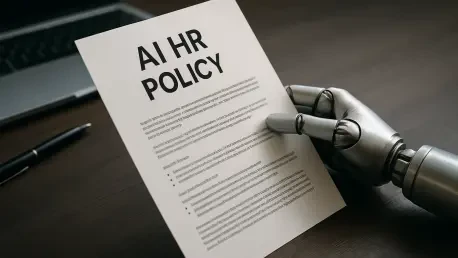As the landscape of work continues to transform, human resources (HR) professionals find themselves at the forefront of navigating an intricate web of policy shifts and technological advancements that are reshaping employer-employee dynamics. Recent developments have spotlighted significant hurdles, from hefty fees on skilled worker visas to the integration of artificial intelligence (AI) in workplace functions, all while employee trust and satisfaction hang in the balance. These changes are not merely operational but strike at the core of how talent is sourced, managed, and retained in a global economy. The tension between protecting domestic jobs and attracting international expertise, coupled with automation’s rapid rise, paints a complex picture for HR departments. This evolving scenario demands adaptive strategies to balance compliance with innovation, ensuring workplaces remain equitable and competitive amidst uncertainty.
Navigating New Immigration Policies and Costs
The recent executive order imposing a staggering $100,000 fee on new H-1B visa petitions has sent ripples through industries reliant on skilled foreign talent. Announced just months ago, this policy significantly raises the financial burden on employers, potentially deterring companies from hiring international workers. The measure reflects a broader push to prioritize domestic labor, yet it risks alienating businesses that depend on global expertise to drive innovation. For HR teams, this means rethinking talent acquisition strategies, possibly shifting focus to local recruitment or investing in upskilling programs for existing staff. The challenge lies in maintaining a diverse workforce while grappling with increased costs, which could strain budgets and limit access to specialized skills critical for growth.
Beyond the immediate financial impact, this policy shift underscores a deeper debate about immigration’s role in the economy. HR departments now face heightened scrutiny from stakeholders questioning the ethics and practicality of such restrictive measures. Balancing compliance with the need for a competitive edge requires careful navigation of legal frameworks while advocating for policies that support long-term organizational goals. The ripple effects are felt in workforce planning, as companies may need to explore alternative visa categories or relocate operations to regions with more favorable regulations. This evolving landscape demands agility from HR leaders to adapt without compromising on talent quality or diversity initiatives.
Addressing Employee Sentiment Post-Layoffs
Recent data from employee feedback platforms reveals a troubling trend: companies that have conducted layoffs are experiencing a noticeable decline in workplace satisfaction ratings. On average, these employers see a drop of 0.13 points on a five-point scale, with top-rated organizations facing even steeper declines. This statistic highlights a pervasive sense of insecurity among workers, as layoffs not only impact those directly affected but also erode trust and morale across the broader workforce. For HR, the task is to rebuild confidence through transparent communication and robust support systems for remaining employees, ensuring they feel valued despite organizational restructuring.
This decline in sentiment also poses reputational risks for employers, as negative feedback can deter potential talent from joining. HR teams must prioritize strategies that address these perceptions, such as offering career development opportunities or enhancing employee wellness programs to counteract the fallout from layoffs. The focus should extend beyond immediate damage control to fostering a culture of stability, where workers believe in the company’s commitment to their growth. By proactively tackling these challenges, HR can mitigate the long-term impact on engagement and retention, turning a potential crisis into an opportunity to strengthen workplace bonds.
Confronting Legal Battles Over Workplace Rights
Legal disputes are increasingly shaping the HR agenda, as evidenced by recent lawsuits over unreimbursed expenses related to workplace policies. In Colorado, a group of employees has claimed up to $253.50 per person for dress code costs, alleging violations of state labor laws. Similar cases in other states signal a growing movement among workers to hold employers accountable for fair compensation practices. These legal challenges reflect a broader push for transparency and equity, compelling HR to scrutinize internal policies to ensure compliance with local regulations while addressing employee grievances before they escalate into costly litigation.
The implications of these disputes extend to how HR designs and communicates workplace rules. Proactive measures, such as regular policy reviews and clear documentation of expense reimbursement processes, become essential to prevent misunderstandings. Additionally, fostering an open dialogue with employees about their rights can help build trust and reduce the likelihood of legal action. As workers become more aware of labor laws, HR must stay ahead by aligning practices with evolving standards, ensuring that fairness remains at the heart of organizational culture while safeguarding against potential financial and reputational risks.
Adapting to AI Integration and Employee Trust
The rapid adoption of AI in workplace functions is transforming HR operations, with surveys indicating that nearly 3 in 10 companies have already replaced certain roles with automation, particularly targeting high-salary positions. This shift raises critical concerns about job displacement and the urgent need for reskilling initiatives to prepare employees for an AI-driven future. HR faces the dual challenge of leveraging technology to enhance efficiency while ensuring that the workforce remains adaptable and relevant. The focus must be on creating training programs that bridge skill gaps, particularly for those at risk of being sidelined by automation.
However, the integration of AI is not without friction, as employee trust in such technologies remains shaky. Recent polls show that 34% of Americans are uneasy with AI being used to calculate pay, and 45% oppose its application in payroll inquiries. This skepticism highlights a significant barrier for HR in deploying automated systems for sensitive functions. Building confidence requires transparent communication about how AI tools operate and the safeguards in place to protect data and fairness. By addressing these concerns head-on, HR can pave the way for smoother technology adoption, ensuring that innovation aligns with employee expectations and ethical standards.
Reflecting on HR’s Path Forward
Looking back, the journey of HR through recent months reveals a field at a pivotal crossroads, grappling with the weight of stringent visa fees, declining employee morale after layoffs, legal challenges over workplace rights, and the cautious integration of AI. Each of these elements tests the resilience of HR strategies, demanding innovative responses to maintain balance in a turbulent environment. The insights gained underscore the importance of adaptability, as policies and technologies reshape the very fabric of work. Moving ahead, HR leaders must focus on crafting forward-thinking solutions, such as investing in comprehensive training to counter automation fears and establishing clear, compliant policies to prevent legal disputes. Strengthening employee trust through open communication emerges as a cornerstone for navigating future uncertainties, ensuring that workplaces not only survive but thrive amidst evolving challenges.









